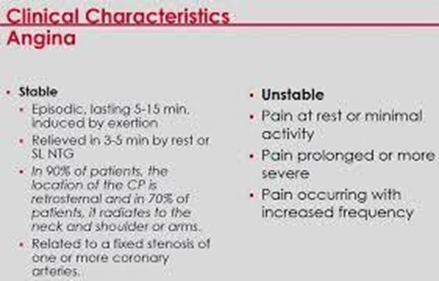A client asks the nurse to explain the difference between stable and unstable angina.
What is the best response by the nurse?
"Stable angina is predictable in its frequency, intensity, and duration. Unstable angina is when angina episodes become more frequent or severe, and occur during periods of rest.”
"Unstable angina is predictable in its frequency, intensity, and duration. Stable angina is when angina episodes become more frequent or severe, and occur during periods of rest.”
"Stable angina is caused by spasms of the coronary arteries. Unstable angina is when angina episodes become more frequent or severe, and occur during periods of rest.”
"Unstable angina is caused by spasms of the coronary arteries. Stable angina is when angina episodes become more frequent or severe, and occur during period of rest."
The Correct Answer is A
A. Stable angina is predictable and typically occurs with exertion or emotional stress and is relieved with rest or nitroglycerin. Unstable angina is less predictable and more serious, occurring at rest, with minimal exertion, or worsening pattern from stable angina.

B. This answer misrepresents the characteristics and causes of stable and unstable angina, mixing definitions or incorrectly assigning causes.
C. This answer misrepresents the characteristics and causes of stable and unstable angina, mixing definitions or incorrectly assigning causes.
D. This answer misrepresents the characteristics and causes of stable and unstable angina, mixing definitions or incorrectly assigning causes.
Nursing Test Bank
Naxlex Comprehensive Predictor Exams
Related Questions
Correct Answer is B
Explanation
A. The symptoms described are characteristic of mania, not indicative of an overdose of barbiturates.
B. The symptoms described align with a manic episode, which is a hallmark feature of bipolar disorder.
C. These symptoms are not typically associated with lithium side effects.
D. The symptoms described are not consistent with depression but rather with mania.
Correct Answer is A
Explanation
A. Fever is one of the hallmark symptoms of serotonin syndrome, along with other signs such as agitation, confusion, rapid heart rate, dilated pupils, and sweating.
B. Tinnitus is not a typical symptom of serotonin syndrome but may indicate other issues or side effects.
C. Bruising is not a typical symptom of serotonin syndrome but may indicate other issues or side effects.
D. Rash is not a typical symptom of serotonin syndrome but may indicate other issues or side effects.
Whether you are a student looking to ace your exams or a practicing nurse seeking to enhance your expertise , our nursing education contents will empower you with the confidence and competence to make a difference in the lives of patients and become a respected leader in the healthcare field.
Visit Naxlex, invest in your future and unlock endless possibilities with our unparalleled nursing education contents today
Report Wrong Answer on the Current Question
Do you disagree with the answer? If yes, what is your expected answer? Explain.
Kindly be descriptive with the issue you are facing.
